Site menu:
This Welsh Shore site guide includes the following areas:
| Shotton and Connah's Quay. |
|
Flint and Bagillt. |
| Greenfield and Fynnongroyw |
| Point of Ayr and Talacre. |
| Gronant. |
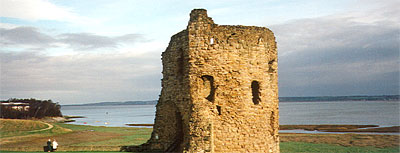
The Welsh Shore - Ancient and Modern, from the ruins of Flint Castle to modern Business Parks. Cut off for much of its length by the Chester to Holyhead railway the estuary manages to be remote and largely undisturbed despite the adjacent towns and industry. Here the Dee Estuary is bordered by the Welsh hills, whose valleys are filled by woods full of birds and good walks. Below is a description of the five main birdwatching areas.
Shotton and Connah's Quay
Shotton and Shotwick
Shotton Lagoons reserve, in the Shotton Steel Works site, is famous for its nesting Common Terns with one of the largest colnies in the country - acces is by permit only. A reed bed, lake and scrub means there is a good selection of bird species here.
To the north and east of the A548 as it passes Deeside Industrial Park are the Shotwick fields and boating lake. The fields hold flocks of Pink-footed Geese and wild swans and the boating lake attracts a good selection of water birds in the winter. The cycle path going towards Burton Point gives good views over a part of Burton Mere Wetlands RSPB only distantly visible from the main hides.
Connah's Quay
Both the footpaths along the River Dee (which are accessible from the old Queensferry bridge) and the Wharf at Connah's Quay afford good views of the Dee. It is very much a river here, rather than estuarine, although it is still tidal. Duck and Cormorants use the river as a flyway and waders can be seen on the sand and mud banks at low tide. Terns use the river for fishing in the summer.
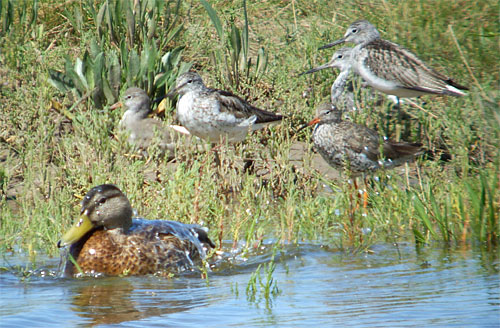
Connah's Quay Reserve
The reserve adjacent to the Gas Power Station overlooks the head of the
estuary. It has a variety of habitats from fresh water to salt attracting
a wide range of bird species. Among the many birds to be seen are Pintail, Wigeon, Teal,
Redshank, Knot and Black-tailed Godwits with the occasional
Merlin, Sparrowhawk and Peregrine Falcon. In the summer Mute Swan, Skylark
and Tree Sparrow breed. The reserve is open only to members of the
Deeside Naturalists' Society.
Wepre Park includes extensive woodland with a pleasant stream running
through. Within the wood Ewloe Castle adds some historical interest. Along
the stream Dippers and Grey Wagtails can be seen whilst the woods have a
large range of woodland species including Tree Pipits, Wood Warblers and
Cuckoos.
Top of page.
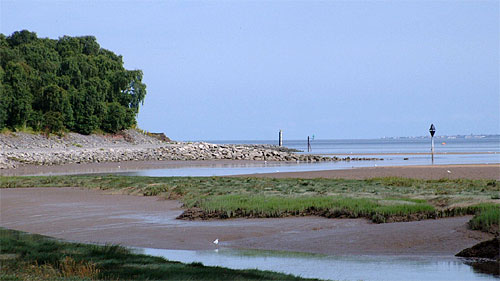
Shelduck and Wigeon when the tide is out. Great Crested Grebes and Red-Breasted
Mergansers are often on the sea in good numbers at high tide.
Flint
Excellent views of the birds on the Estuary can be had from Flint Castle and the adjacent shore paths. As well as its historical interest the Castle has breeding Ravens, worth a visit for that alone! Just to the north of the castle is Flint Point which gives an excellent view across the estuary.
Flint marsh to the south of the castle is a good high tide roost with the usual waders including Black-tailed Godwits and Grey Plover, and also plenty of Teal and Shelduck. In recent winters Little Egrets and Spoonbills have been seen here. The RSPB reserve at Oakenholt, just to the south of Flint marsh, has the same species of birds present including a large wader roost.
Bagillt
The footpath to Bagillt is on a seawall bordered on one side by the sea
marsh and the other by bush thickets including Hawthorn and a fresh water
marshy area. Wheatears are seen in spring and Sedge Warblers breed.
Several Great Crested Grebe use the channel as a good place to hunt for
fish all year round, and at times can reach well over one hundred birds.
Raptors include regular visits by Buzzards and Sparrowhawks.
Top of page.
Greenfield and Fynnongroyw
Greenfield
At Greenfield the seawall drops straight down to the channel of the River
Dee with only a few mud banks exposed at low tide. This is a great place
to see fish eaters at low tide - Great-crested Grebes spring or autumn,
Red-breasted Mergansers in the spring, Terns late summer/ early autumn and
Cormorants all year round. In the summer the seawall is full of wild
flowers and nesting birds such as Yellowhammers and Stonechats. Greenfield
Valley Country Park is well worth a look with a species count of ninety
five including three species of Woodpecker, five species of Tit and Pied
and Spotted Flycatchers, as well as more unusual visitors such as Red
Kite, Hobby and Osprey. It is a fascinating area of industrial ruins,
woodland, stream and lakes. A more detailed look at the Greenfield Valley
can be seen in the
February 2001 Newsletter.

Fynnongroyw
The view from the footbridge at Ffynnongroyw reveals an extensive mud flat
(Mostyn Bank) ideal for feeding waders and Shelduck. There is a shell
beach here, literally 'shell', I have never seen anywhere with more cockle
shells washed up by the tide! With all those cockles around the place has
large numbers of Oystercatchers.
Garth Wood, like Wepre Wood mentioned above, attracts Dippers and Grey
Wagtail to its streams. The place is alive with birdsong in the spring
with several members of the Tit and Warbler family breeding along with
Woodpeckers and Jays. This wood offers more of a challenge than Wepre Wood
as it is very overgrown, it is also little visited. Garth Wood is owned by
the Woodland
Trust .
Talacre and Point of Ayr
On
the way to Talacre look out for roosting waders in the flooded fields
on Warren Farm which is SSSI and managed so as to create a good wetland
habitat for waders and wildfowl. The Point of
Ayr itself is a renowned high tide roost with superb views of
Pintail, Oystercatchers, Knot, Dunlin, Redshank, Curlew and Ringed
Plover. In the Spring and Autumn migrating birds swell the ranks
including both Black and Bar-tailed Godwits. There is a hide here
although it does suffer from vandalism.
The beach and lighthouse looking out towards the Irish Sea is a good
place for Sea watching bringing the possibilities of migrating Terns,
Gannets, Skuas, Leach's Petrel, Kittiwakes plus various sea ducks. The
beach itself is a prime spot for Snow Buntings in the winter.
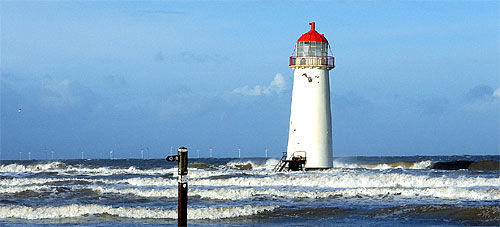
Among the sand dunes and marsh behind the beach can be observed Whinchat, Wheatear, Stonechat, Skylark and various Warblers. The Warren (between the end of Station Road and the lighthouse) is an area of scrub abd sand dines, it is a particularly good place to see migrants.
See
August 2006 Newsletter for a detailed Point of Ayr site guide.
Top of page.
Gronant
Gronant is a beautiful area of marsh, sand dunes, shingle and sandy beach.
Despite being so close to numerous caravan parks it has a wild air about
it almost as if it was in one of the more remoter parts of the Hebrides!
In winter the lake and river can attract a good selection of duck and the
sand dunes and beach may hold Snow Buntings. The wide sandy beach and sea beyond is always full of gulls, worth
a good look for something out of the ordinary. The beach is also used as a
roost for Cormorants and several species of Tern in summer, and as a wader
high tide roost in winter being particularly attractive to Sanderling. The
marsh contains locally important numbers of Snipe.
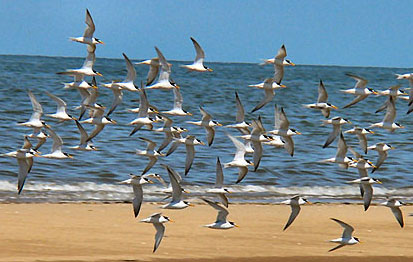
In summer the place is alive with the song of skylarks and numerous colourful wild flowers. Little terns, Oystercatchers and Ringed Plovers nest in the area and the Denbighshire Countryside Rangers run a wardening scheme (including volunteers) throughout the summer to protect the Little Tern colony. In the marsh Water Rail, Snipe, Reed Buntings and various warblers nest.
To the east of Gronant sand dunes, and just inland of Presthaven Caravan Park and the railway is Big Pool Wood run by the North Wales Wildlife Trust. It is dominated by common reed, this reserve is an important habitat for breeding reed warblers and wintering wildfowl. Surrounding the reed bed is wet woodland predominantly of alder containing several locally rare plants including giant bellflower. The site is part of the Dee Estuary SSSI. A circular path gives you a chance to explore this quiet little reserve.
Top of page.